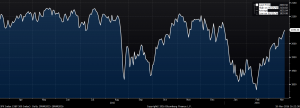In 2016, the market got off to one of its worst starts in history. At its February 11th close, the S&P 500 was down about 11% from where it ended 2015; it was also more than 14% below its May 21, 2015, record close. Many investors were worried, especially those with a short-term outlook. We know how difficult it is to forecast where the market might go next, so we are not going to say that new highs are on the horizon. At the same time, we do know that on Friday, the S&P moved into positive territory year-to-date.
S&P 500 Index Year-to-Date Performance
In this year’s first six weeks, investors were worried about factors such as slowing growth in China and the other developing markets, economic weakness in Europe and Japan, tumbling oil prices, and the direction of the U.S. Federal Reserve’s interest policies, including criticism that the Fed had wrongly raised rates in December. There were also some concerns that recession was coming to the U.S. A mere five weeks later, the stock market has reversed course.
What is driving the market’s turnaround? First, oil prices, which have seemingly moved in lockstep with the stock market for the past few months, have surged, rising 53% in the last 24 trading days. Recent data also supports the view that our economy continues to grow at a slow, albeit steady, pace.
The market’s strong performance last week was also aided by the latest news from the Federal Reserve. Until last week, the Fed continued to project that it would raise interest rates four times in 2016. While the environment in Asia and Europe worsened, the Fed maintained its view. The Fed held another policy meeting last week. It was not surprising to learn that interest rates would remain unchanged. However, the market took a favorable view of the Fed’s “dovish” outlook. At her press conference following the meeting’s conclusion, Fed chairwoman Janet Yellen said, “What you see here is a virtually unchanged path of economic projections and a slightly more accommodative path.” Or, in plain English, rates will stay lower for longer.
Ms. Yellen provided two reasons for the change in policy. First, she noted that while the U.S. is getting back to normal, the rest of the world is suffering from slow growth. It is particularly difficult for the Fed to raise rates when so many other central banks are lowering them. Second, the market has already done much of the Fed’s work as lending standards have tightened.
Previously, the Fed expected four rate hikes this year and next, taking rates to around 2.5% by 2017’s end. Now only two hikes are expected this year and the majority of the Fed’s members believe rates will be below 2% by next year’s end. This lower-for-longer environment should be a net positive for stocks.
Against this backdrop, we remain focused on controlling and improving our processes. At the same time, we aim to avoid the type of short-term thinking and herd-like behavior that can lead to higher risk and weaker returns. As a result, our goal continues to be to deliver long- rather than short-term gains. Our belief is that by remaining true to our approach of following a well-thought out process to help us select well-managed companies with strong balance sheets, that generate above-average margins and are trading at attractive valuations will provide the best opportunity to deliver solid long-term gains to client portfolios.


